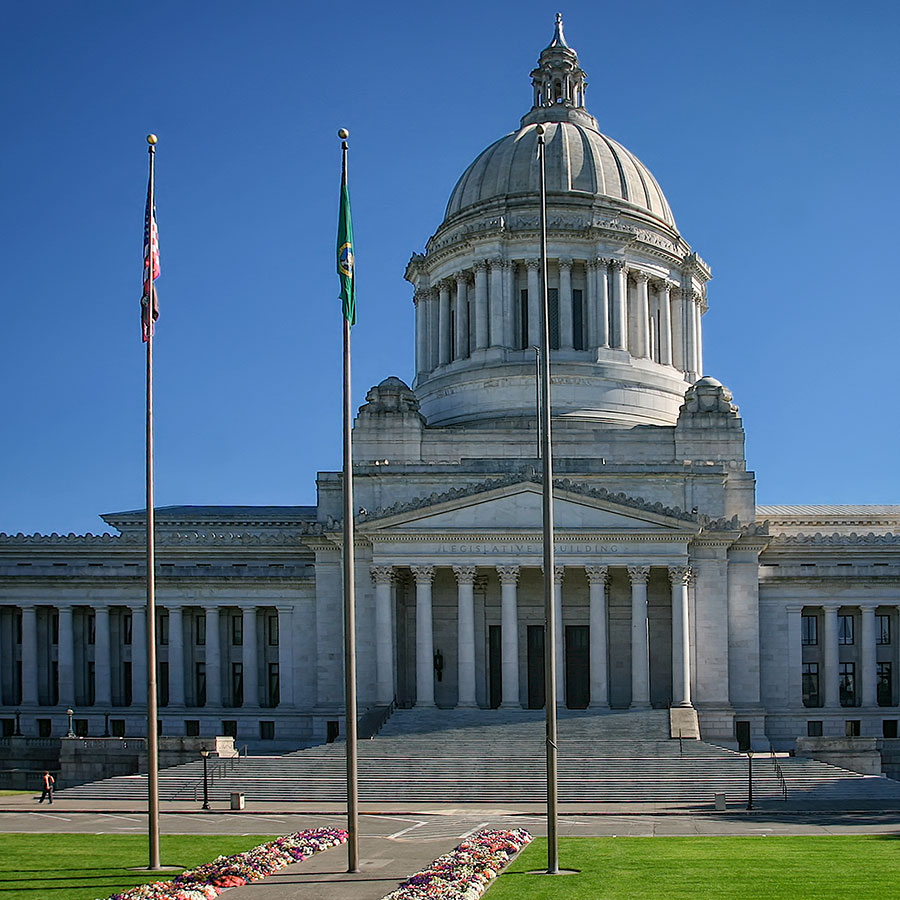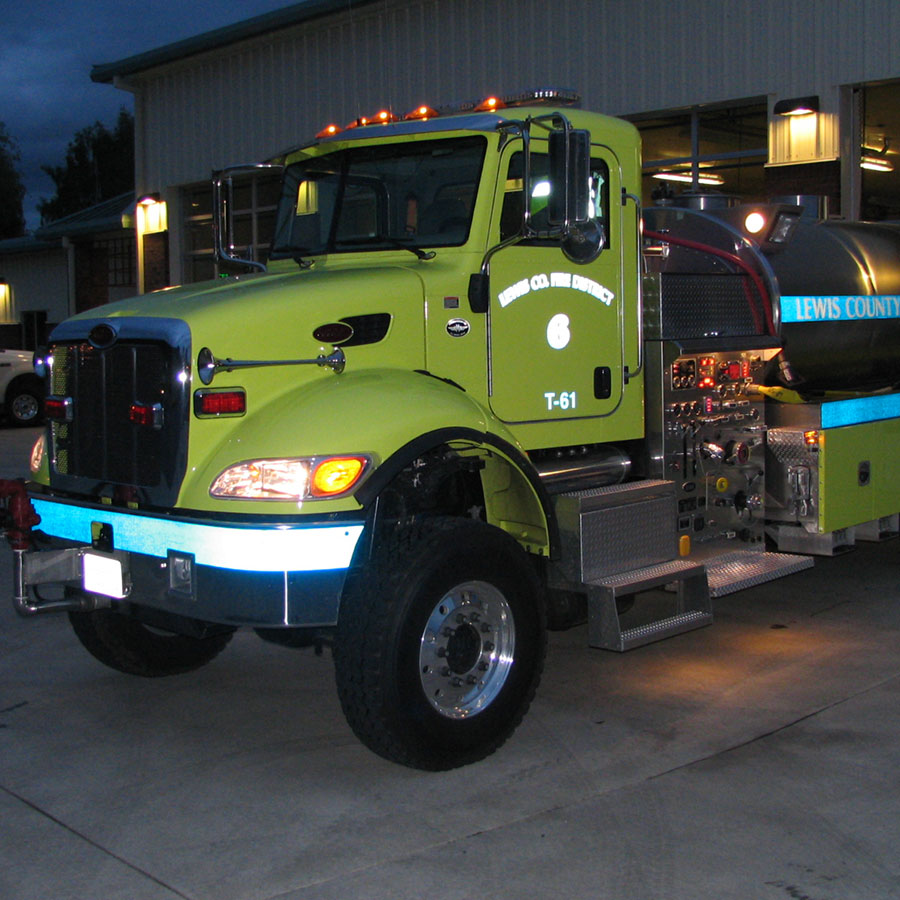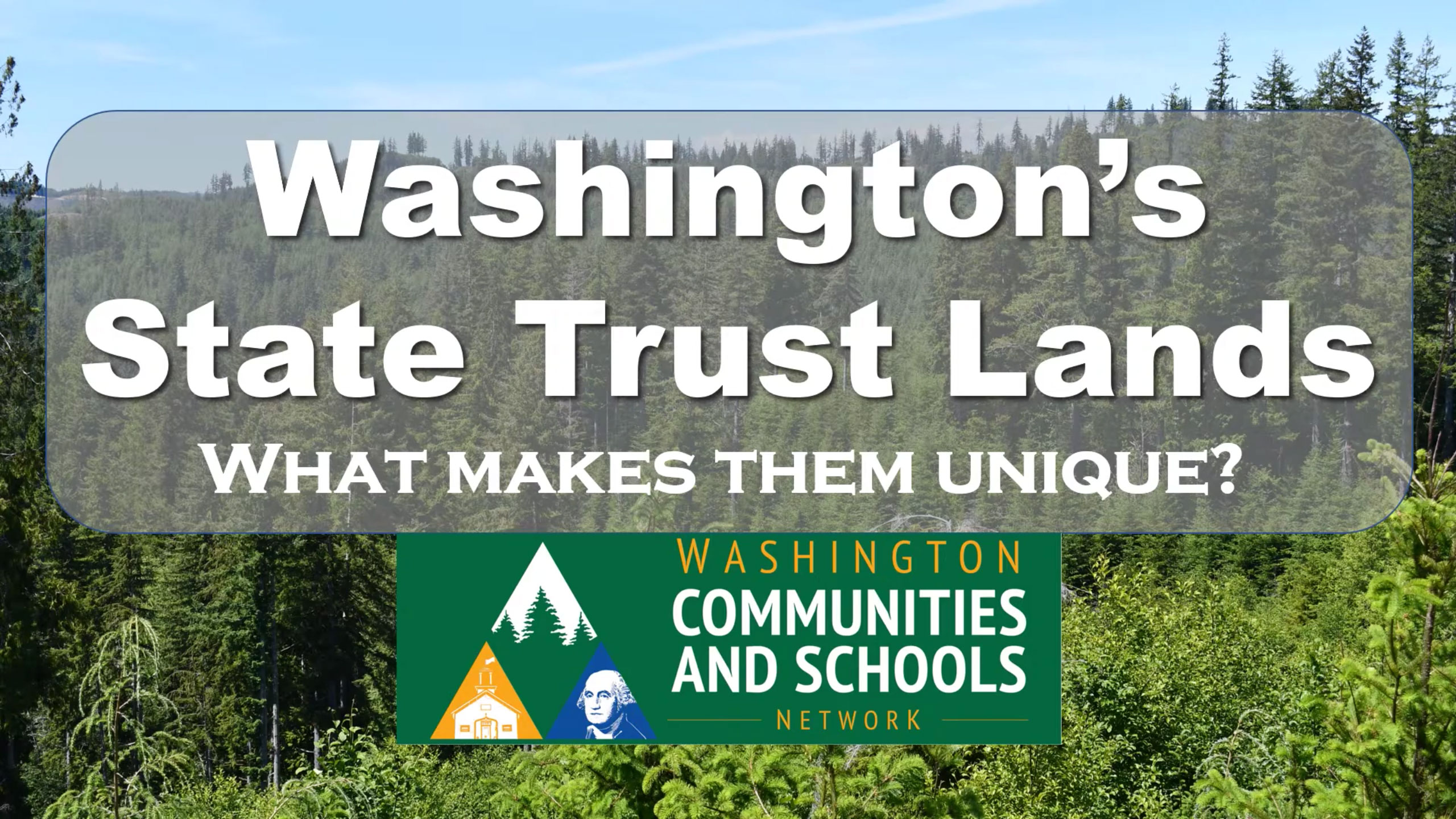DNR State Trust Lands – Key Facts
Enabling Act, State Constitution, and Skamania v. Washington define the trust requirements and who the beneficiaries are.
The legislature is the Trustee and DNR is the trust manager.
Multiple Use Act (RCW 79.10.120) requires the beneficiaries to be compensated when revenue production is harmed or the non-trust use cannot be allowed.
Today, about 2.8 million acres of the original 3,718,480 total acres remain in trust status statewide.
About 2.1 million acres are forested with about 1.4 million acres located west of the Cascade crest.
In western Washington, over 45% of trust acres are removed from management under various policies including old-growth, endangered species conservation and some estimates put it as high as 55%+ removed from trust management.
Enabling Act, State Constitution, and Skamania v. Washington define the trust requirements and who the beneficiaries are.
The legislature is the Trustee and DNR is the trust manager.
Multiple Use Act (RCW 79.10.120) requires the beneficiaries to be compensated when revenue production is harmed or the non-trust use cannot be allowed.
Today, about 2.8 million acres of the original 3,718,480 total acres remain in trust status statewide.
About 2.1 million acres are forested with about 1.4 million acres located west of the Cascade crest.
In western Washington, over 45% of trust acres are removed from management under various policies including old-growth, endangered species conservation and some estimates put it as high as 55%+ removed from trust management.
What are DNR Managed State Trust Lands?
An endowment supporting schools and communities since 1889.
State trust lands are lands managed by the Department of Natural Resources for the benefit of defined beneficiaries. The lands are primarily timber lands, but also include agriculture lands, commercial properties, and other miscellaneous lands. These lands are all intended to be used to generate revenue for the named beneficiaries of the trust. The legislature is the trustee of these lands and had delegated management of the trust assets to the Department of Natural Resources. These lands are generally broken into two buckets: Federally Granted Lands and “County” trust lands.
Major Trusts Managed by DNR (by Current Acreage)
K-12 Common School Trust
State Forest Transfer / Purchase
Agriculture & Science Trust (Washington State University)
Capitol Building Trust
University Trust (University of Washington)
Charitable, Educational, Penal & Reformatory Institutions Trust
Normal School Trust
King County Water Pollution Control Division Trust
Community College Forest Reserve Trust
Trust Land Endowment (by Asset Class)
TOTAL | 2,875,000 | $254,366,000 |
|---|---|---|
ASSET CLASS | APPROXIMATE ACREAGE | GROSS REVENUE* |
| Forest | 2,195,000 | $228,885,000 |
| Agriculture | 191,000 | $9,096,000 |
| Grazing | 436,000 | Included in Agriculture |
| Commercial (Leased) | 11,000 | $16,383,000 |
| Non Income | 42,000 | 0 |
TABLE SCROLLS RIGHT ON MOBILE
*Revenue numbers from 2005 annual report and do not include revenue from other sources.
Federally Granted Lands
Purpose: To be managed in trust to support common schools and other state public facilities.
Washington State was granted over 3 million acres of land by the U.S. Congress when Washington became a state in 1889. These lands were specifically granted to the state in trust to generate long-term funding for school construction, universities, and other public services.
The use of these lands is to fund “common schools, and such high schools, normal schools, and technical schools as may hereafter be established.” The purpose and use of these lands is controlled by both the Enabling Act of 1889 which admitted Washington into the Union as a State as well as the Washington State Constitution. Articles 9 and 16 in the Washington State Constitution are the primary articles related to Federally Granted Trust Lands.
Today, due to land sales and exchanges, transfer out of trust status for environmental purposes (Trust Land Transfer for example), and other trust management decisions, DNR now manages about 2.25 million acres of the original 3.1 million acres granted at statehood.

TOTAL | 2,432,000 | 100,000 | 190,000 | 46,000 | 200,000 | 132,000 | 3,100,080 |
|---|---|---|---|---|---|---|---|
COMMON SCHOOL | NORMAL SCHOOL | WSU (AG&SCI) | UW* | CEP&RI | CAPITOL BUILDING | TOTAL | |
| 1889 | 1,498,000 | 100,000 | 190,000 | 46,000 | 200,000 | 132,000 | 2,266,080 |
| Lieu Lands | 934,000 | 0 | 0 | 0 | 0 | 0 | 934,000 |
TABLE SCROLLS RIGHT ON MOBILE
*University of Washington (UW) received 46,080 acres in 1854 and an additional 100,000 acres from the CEP&RI endowment in the early 1900s.
State Forest Lands (aka County Trust Lands)
Purpose: To be managed in trust to support local public services.
Beginning in the late 1920s into the 1930s, an additional 618,400 acres of timberlands were transferred to the State by the counties and placed into trusts to generate revenue through timber harvest and other revenue-generating activities for local counties and government entities including schools, libraries, fire districts, and parks. These lands were typically acquired through tax foreclosures. For many counties the scale of the work needed to reforest and manage these lands was immense. As such a plan was devised to transfer title in trust to the State to manage on behalf of the counties and their Junior Taxing Districts.
Total State Forest lands endowment: 618,400 acres
These lands are:
- Chiefly valuable for developing and growing timber.
- Economically feasible for forest management.
- Revenues to support counties and junior taxing districts.
These “County” trust lands have been affirmed in Skamania v. Washington to hold the same trust fiduciary trust status as other trusts. Revenues, minus a management fee, from the lands are distributed to the counties where the timber harvest or other income producing activity has occurred. With the exception of a few counties (Klickitat, Skamania, and Wahkiakum) whose population is below 25,000 people, the revenues are distributed to the Junior Taxing Districts (JTDs). These JTDs are schools, fire districts, library districts, port districts, and many others.
Today, DNR manages about 625,000 acres for the benefit of counties and junior taxing districts. This change in acreage is primarily due to land exchanges, inter-trust exchanges, and other trust management decisions.

TOTAL | 79,400 | 539,000 | 618,400 |
|---|---|---|---|
STATE FOREST PURCHASE | STATE FOREST TRANSFER | TOTAL | |
| 1920s | 79,400 | 0 | 79,400 |
| 1930s | 0 | 539,000 | 539,000 |
TABLE SCROLLS RIGHT ON MOBILE
Trust lands provide essential revenues for public services in Washington State.

The Board of Natural Resources
The Board of Natural Resources oversees policy and trust management duties performed by the DNR. The Board’s duties are to:
- Establish policies to ensure acquisition, management, and disposition of all lands and resources within the department’s jurisdiction, and are based on sound principles and in alignment with trust manager duties.
- Constitute the Board of Appraisers
- Constitute the Commission on Harbor Lines.
- Approve timber sales.
- Approve all land transactions.
- Constitute the Board of Geographic Names.
The Board meets on the first Tuesday of every month at 9:00 AM, except for August. August is typically reserved for a Board retreat.
The Board is comprised of six members. The Commissioner traditionally chairs the Board but by statute is the Board secretary.
Members of the Board
- Dave Upthegrove
Chair of the Board / Commissioner of Public Lands, Department of Natural Resources (Olympia, Washington) - Lisa Janicki
Vice-Chair of the Board, Represents County Beneficiaries and is recommended by the “Timber County” members of the Washington Association of Counties (WSAC) / Skagit County Commissioner - Chris Reykdal
Represents the Common School trust / Washington State Superintendent of Public Instruction (Olympia, Washington) - Jim Cahill
Represents other Federally granted trusts / Senior Budget Assistant to the Governor for Natural Resources, Designee for Governor Jay Inslee (Olympia, Washington) - Wendy Powers-Schilling
Represents Washington State University and associated trusts / Dean, College of Agricultural, Human & Natural Resource Sciences, Washington State University (Pullman, Washington) - Dan Brown, Ph.D.
Represents the University of Washington and associated trusts / Director, School of Environmental and Forest Sciences, College of the Environment, University of Washington (Seattle, Washington)
Policy for Sustainable Forests
The Policy for Sustainable Forests (PSF) approved by the Board of Natural Resources, guides DNR’s long-term sustainable management of 2.1 million acres of forested state trust lands statewide. The PSF, adopted in 2006, replaces the 1992 Forest Resource Plan.
The PDF below is a complete document (hard copies no longer in print).
State Trust Lands Habitat Conservation Plan
Washington’s State Trust Lands Habitat Conservation Plan (HCP) is a multi-species agreement between the Department of Natural Resources and the Federal government. Specifically, the US Fish and Wildlife Service and the National Marine Fisheries Service. The HCP expires in 2067 but has two optional 15-year voluntary extensions included in the plan. This long-term plan outlines how DNR will provide habitat for species such as the northern spotted owl, marbled murrelet, and riparian-dependent species, such as salmon and bull trout, which are listed as threatened or endangered under the federal Endangered Species Act.
The HCP applies to forested state trust lands within the range of the northern spotted owl. However, it was designed as a multi-species plan to provide habitat for other species that depend on the same habitats as the listed species. Some of these other species may also be declining in numbers. The plan also includes several thousand acres of conservation lands managed by DNR for their natural values, research opportunities, and low-impact recreation.
What does the Trust Lands Habitat Conservation Plan protect?
The core of the State Trust Lands Habitat Conservation Plan is its four detailed conservation strategies for northern spotted owls, marbled murrelets, riparian and wetland areas, salmonids, and other species of concern and uncommon habitats. These conservation strategies focus on protecting habitat as a surrogate for protecting the species, even if the species is not present. Habitats protected under the State Trust Lands HCP include:
- Habitat for northern spotted owls, marbled murrelets, and riparian-dependent species such as salmon.
- Habitat for other animal and plant species listed as threatened or endangered by the federal or state governments.
- Habitat for unlisted plant or animal species that might be declining in numbers or that could be listed at some future time.
- Uncommon habitats and habitat elements (talus fields, caves, cliffs, oak woodlands, large snags, balds, mineral springs, and large, structurally unique trees) that support the various species that depend on them.
- Old-growth forests in the five habitat conservation planning units in western Washington. (Old growth protections are also identified in the Policy For Sustainable Forests).
- Unstable slopes.
1997 Final Habitat Conservation Plan
The State Trust Lands Habitat Conservation Plan (HCP) approved in 1997 provides ecological guidance to the management of forested state trust lands west of the crest of the Cascade Mountains and those on the eastern slopes of the Cascades, from the Canadian border to the Columbia River. This area is considered the range of the Norther Spotted Owl in Washington state. The lands have been broken into nine planning units based primarily on large watersheds. The HCP enables DNR to manage state forested trust lands for the benefit of the beneficiaries while proving compliance with federal Endangered Species Act requirements. This is accomplished by providing conservation objectives and strategies that provide habitat for listed and unlisted species. The HCP is also intended to provide DNR with greater certainty, flexibility, and stability in meeting its trust responsibilities to generate revenue for trust beneficiaries through activities, such as harvesting timber and other forest products. With the goal of assuring the best value and return possible to the trust beneficiaries.
The PDF below is a complete document.
Sustainable Harvest
The sustainable harvest level is the volume of timber to be scheduled for sale during a planning decade. The sustainable harvest level, often referred to the sustainable harvest calculation of SHC is divided into a western Washington and eastern Washington calculations, using the crest of the Cascade mountain range as the divider.
The SHC is addressed in statute in the Revised Code of Washington (RCW):
- Definitions (RCW 79.10.300)
- “Sustained yield plans” defined (RCW 79.10.310)
- Sustainable harvest program (RCW 79.10.320)
- Arrearages—End of decade (RCW 79.10.330)
- Sustainable harvest sale (RCW 79.10.340)
The DNR determines a level of timber harvest for present and future trust beneficiaries using modeling of present and future forest growth and inventory. This modeling includes financial assumptions related costs and revenues from timber sales. The goal is to produce revenue for the various beneficiaries while meeting the environmental obligations under the HCP and other regulatory requirements. The sustainable harvest level is a policy decision that requires approval by the Board of Natural Resources.
The Board of Natural Resources adopted the Fiscal Year 2015 to 2024 decadal sustainable harvest level for western Washington on December 3rd, 2019. The Board’s resolution (Resolution 1560) set the decadal volume is at 4.65 billion board feet or about 465 million board feet per year. The previous decade (FY ’05-’14) was set at 5.50 billion board feet. The Department ended that decade with an arrearage of based on statute of 462 million board feet. You can download the FY ’15 to ’24 SHC documents and learn more on the DNR’s SHC webpage.
The PDF below is a complete document.
